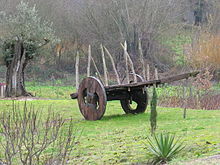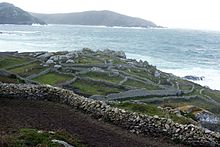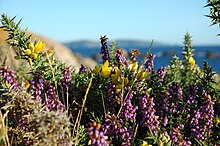A - C
- abanqueiro[2][3] [m] 'waterfall' < *'(beaver) dam', formally a derivative in -arium of *abanco, from Proto-Celtic *abankos 'beaver, water demon'[4][5] cognate of Old Irish abacc 'dwarf', Welsh afanc 'beaver, dwarf', Breton avank 'dwarf, sea monster'. Akin also to Arpitan avans 'wicker'.[6]
- abeneiro [7] [m] 'common alder', a derivative in -arium of *abona 'river', related to Breton aven, Welsh afon, Irish abha/abhainn 'river'.
- abrancar[8] 'to embrace', from Latin branca 'paw', of probable Celtic origin.[9]
- abrollar[10] 'to sprout', from Celtic *brogilos 'copse'.[11]
- álamo [m] 'poplar tree', Germ. *elmaz 'elm' (< *h1elHm-o), Latin ulmus 'elm' (< *h1elHm-o), Celtic *alamo (by Joseph's rule < *elamo < *h1elHm-o).,[12] but Gaulish lemo- / limo- 'elm', Old Irish lem 'elm' (< *limos)
- Old Galician ambas [f p] 'waters, river', ambas mestas [f] 'confluence',[13][14] from Celtic ambe[15] 'water, river', akin to Gaulish ambe 'river', Old Irish abu.
- androlla 'pig's large intestine', from *anterolia 'entrails' < *h1ṇter-o 'that is between, internal', Asturian androya, Sanskrit antrá 'entrails, guts', Armenian ənderk, Hittite andurza 'insides', Greek éntera, Celtic enātro[16]
- angazo 'rake', from *ankatio 'hook' < *h2ṇk-ā-tyo, Asturian angazu and angüezu, old Irish écath ‘fish hook’, middle Welsh anghad < *h2ṇk-o-to (EDPC: 37).[16]
- banzo[2] [m] (alternative spelling banço) 'crossbar, beam', from *wṇk-yo,[4] cognate of Spanish banzo; akin to Irish féice < *wenk-yo, 'ridgepole'.
- Derivatives: banza 'backrest', banzado, banzao 'palisade, dam'.
- barga [f] 'hut; wall made of hurdles; hurdle, fence', from Celtic *wraga,[17][18] cognate of Spanish varga 'hut', French barge, akin to Old Irish fraig, Irish fraigh 'braided wall, roof, pen', Br gwrac'hell 'haybale, rick of hay'.
- Derivatives: bargo 'stake or flagstone used for making fences or walls'; barganzo, bargado 'hurdle, fence'.
- barra [f] 'garret, loft, upper platform', from proto-Celtic *barro-,[4][5] cognate of Irish, Breton barr 'summit, peak, top', Welsh bar
- bascullo [m] 'bundle of straw; broom', from proto-Celtic *baski- 'bundle',[5] cognate of Gascon bascojo 'basket', Asturian bascayu 'broom', Breton bec'h 'bundle, load'.

- berro [m] 'watercress', from proto-Celtic *beru-ro-,[4][5][19][20] cognate of Spanish berro; akin to Old Irish biror, Welsh berwr, Old Breton beror; similarly French berle 'water parsnip' (< berula ; Ir biolar, Breton beler).
- bico [m] 'beak, kiss', from proto-Celtic *bekko-,[5][21][22] cognate of Italian becco, French bec.
- Derivatives: bicar 'to kiss', bicaño 'hill', bicallo (a fish, Gadus luscus).
- bidueiro[2] [m] < *betūlariu, biduo [m] < *betūlu, bidulo [m] < *betūllu 'birch',[23] from Celtic *betu- or *betū-,[4][5] cognate of Spanish biezo, Catalan beç, Occitan bèç (< bettiu); Spanish abedul, French bouleau, Italian betulla (< betula); akin to Irish beith, Welsh bedw, Breton bezv.
- Derivatives: Bidueiral, Bidual 'place with birch-trees'.
- billa,[2] alternative spelling bilha, [f] 'spigot; stick' to Proto-Celtic *beljo- 'tree, trunk',[24] akin to Old Irish bille 'large tree, tree trunk', Manx billey 'tree', Welsh pill 'stump', Breton pil; cognate of French bille 'log, chunk of wood'.
- borba[2] [f] 'mud, slime, mucus', from proto-Celtic *borwâ-,[25] cognate of French bourbe 'mud'; akin to Irish borb 'mud, slime', bearbh 'boiling', Welsh berw 'boiling', Breton berv 'broth, bubbling'.
- Derivatives: borbento 'mucilaginous'.
- borne [m] 'edge', from French borne 'milestone, landmark', from Old French bosne, bodne, from Vulgar Latin *bodĭna / *budĭna 'border tree', from proto-Celtic *botina 'troop'.,[26] akin to Old Irish buiden, Welsh byddin 'army' (from *budīnā)
- braga[2] [f] 'trousers', from proto-Celtic *braco-,[27] cognate of Spanish, Occitan braga, French braie, Italian brache.
- Derivatives: bragal, bragada 'spawn', bragueiro 'trus'.
- braña [f] (alternative spelling branha) 'meadow, bog, quagmire', from proto-Celtic *bragno-,[5][28] cognate of Asturian and Cantabrian braña, Catalan braina, akin to Irish brén, Welsh braen, Breton brein 'putrid'; Ir bréanar, W braenar, Br breinar 'fallow field'.
- Derivatives: brañal, brañeira, brañento 'idem'.
- breixo[29] [m] 'heather', from *broccius,[30] from Proto-Celtic *vroiki-,[24] akin to Old Irish froich, Welsh grug, gwrug, Cornish grug, Breton brug; cognate of Spanish brezo, Occitan bruga, French bruyère.
- Old Galician bren [m] 'bran', maybe from Provençal brem, from proto-Celtic *brenno-,[31] cognate of French bran, Lombard bren.
- bringa[32] [f]'stalk, rod', from *brīnikā, from Celtic *brīnos 'rod'; akin to Welsh brwyn 'rush', Cornish broenn, Breton broen; cognate of French brin 'blade (of grass), stalk'.
- brío[2] [m] 'might, power', from Italian brio, from Catalan/Old Occitan briu 'wild', from Celtic *brigos,[5] cognate of Occitan briu, Old French brif 'finesse, style'; akin to Old Irish bríg 'power', Welsh bri 'prestige, authority', Breton bri 'respect'.
- Old Galician busto [m] 'cattle farm, dairy', from a Celtic compound *bow-sto-[33] meaning 'cow-place', akin to Celtiberian boustom 'cow shed, byre', Old Irish bua-thech 'cow house/byre'; cognate of Portuguese bostar, Spanish bustar
- Derivatives: bustar 'pastures'.
- cai [m] 'quay, jetty', maybe from French (itself from Norman) quai, from proto-Celtic *kag-yo-,[5][34][35] akin to Welsh cae, Cornish ke, Breton kae 'hedge'; French chai 'cellar'.
- callao [m] 'boulder; pebble', from Celtic *kalyāwo- 'stone'.[36]
- cambiar 'to change', from Vulgar Latin cambiare, from proto-Celtic *kambo-,[4][5][37] cognate of French changer, Occitan/Spanish cambiar, Catalan canviar, Italian cambiare; akin to Breton kemm 'exchange', Old Irish cimb 'ransom'.
- Derivatives: cambio 'exchange', cambiador 'exchanger'.
- camba[2] [f] 'wheel rim' from proto-Celtic *kambo-,[4][5][38] cognate of Old Irish camm 'crooked, bent, curved'. Cognate of Occitan cambeta 'part of plough', Limousin Occitan chambija (< *cambica) 'part of plough'
- Derivatives: cambito, cambada, camballa, cambeira 'coil; crooked log for hanging fish', cambela 'type of plough', cambota 'beam'.
- camiño[2][39] [m] 'pathway', alternative spelling caminho, from Vulgar Latin *cammīnus, from proto-Celtic *kanxsman-,[5][40] cognate of Italian cammino, French chemin, Spanish camino, Catalan camí, Occitan camin; akin to Old Irish céimm, Cornish and Breton kamm 'step', Asturian galmu 'step' < *kan-mo.[16]
- Derivatives: camiñar 'to walk'.
- camisa[2] [f] 'shirt' from Latin, from Gaulish camisia.[41] cognate of Spanish/Occitan camisa, Italian camicia, French chemise
- cando [m] 'dry stick', from medieval candano, from Celtic *kando- 'bright, white', cognate of Welsh cann 'bright, light'.[42]
- canga'[2][43] [f] 'collar, yoke', from Celtic *kambika.[44] Akin to Irish 'cuing' yoke.
- canto [m] 'rim, corner', from proto-Celtic *kanto-,[4] akin to Old Irish cét 'round stone pillar, Welsh cant 'tire rim', Breton kant 'disk'; cognate of Old French chant, Occitan cant, Spanish canto.
- Derivatives: recanto 'corner', cantón 'edge of a field', acantoar 'to hide, to isolate', cantil 'cliff'

- carozo [m] 'fruit core', asturian caruezu, both from *karosio < *kro-o-syo, related with Celtic *karīso ‘fruit core’ (< *kro-ī-so, Welsh ceri, Schrijver 1991, 208) and Latin carīna ‘nut shell’ (< *kro-is-na, EDL: 93).
- carro [m] 'cart, wagon', from Vulgar Latin carrum, from proto-Celtic *karro-,[4][5][45] cognate of Rumanian car, Italian carro, French char, Provençal car, Spanish carro; akin to Irish carr, Welsh car, Breton karr.
- Derivatives: carreira 'road', carregar 'to load'.
- caxigo [m] 'oak; Portuguese oak', from *cassīcos, from Celtic *cassos 'curly, twisted',[46] akin to Irish cas 'twist, turn, spin', Old Welsh cascord 'to twist'; cognate of Asturian caxigu, Aragonese caixico, Gascon casse, French chêne 'oak' (< *cassanos).
- centolo [m] 'European spider crab', akin to Gaulish personal name CINTULLOS 'the first one',[47] from PCl *kintu- 'first'.
- cervexa[2] [f] 'beer', alternative spelling cerveja, from Vulgar Latin *cerevisia, from Gaulish[48] Cognates: Old French cervoise, Provençal, Spanish cerveza; akin to Old Irish coirm, Welsh cwrw, Cornish and Breton korev.
- cheda[2] [f] 'lateral external board of a cart, where the crossbars are affixed', from Medieval Latin cleta, from proto-Celtic *klētā,[4][5][49] cognate of Irish cloí (cloidhe) 'fence', clíath 'palisade, hurdle', Welsh clwyd 'barrier, wattle, scaffolding, gate', Cornish kloos 'fence', Breton kloued 'barrier, fence'; cognate of French claie 'rack, wattle fencing', Occitan cleda, Catalan cleda 'livestock pen', Basque gereta.
- choco [m] 'cowbell; squid', from proto-Celtic *klokko-,[4][5][50] akin to Old Irish clocc, Welsh cloch, Breton kloc'h; cognate of Asturian llueca and llócara 'cowbell', French cloche 'bell', German Glock.
- Derivatives: chocar 'to bang, to shock', chocallo 'cowbell'.
- colmea[2] [m] 'beehive', from a Celtic form *kolmēnā 'made of straw'[51] (cf. Spanish colmena 'beehive'), from *kolmos 'straw', which gave Leonese cuelmo; cf. Welsh calaf "reed, stalk", Cornish kala and kalaven "straw", Breton kolo "stalk").
- cómaro, comareiro [m] 'limits of a patch or field, usually left intentionally unploughed', from proto-Celtic *kom-ɸare-(yo)-,[5] cognate of Old Irish comair 'in front of', Welsh cyfair 'direction, place, spot, acre'. Or either to *kom-boros 'brought together'.[52]
- Derivatives: acomarar 'to mark out a field (literally to dote with cómaros)'.
- comba [f] 'valley, inflexion', from proto-Celtic *kumbā,[4][5][53] cognate of North Italian comba, French combe, Occitan comba; akin to Irish com, Welsh cwm 'hollow (land form)', Cornish komm 'small valley, dingle', Breton komm 'small valley, deep water'.
- combarro [m], combarrizo [m] 'shed, shelter',[54] from proto-Celtic *kom-ber-o- 'bring together'.[5] Cognate of Middle French combres 'palisade in a river, for fishing'.
- combo [m] (adj.) 'curved, bent', from Celtic *kumbo-,[4][5][55] cognate of Provençal comb, Spanish combo.
- Derivatives: combar 'to bend'.
- comboa [f] 'corral used for capturing fish trapped in low tide', from Old Galician combona, from Celtic *combā 'valley' or *cambos 'bent'.[55]
- croio [m] 'rolling stone', croia [f] 'pip', from old-galician crougia > *cruia 'stone', Proto-Celtic *krowka (EDPC: 226, Oir. crùach 'hill'. W. crug 'cairn, hillock'.[56] Derivatives: croio (adj.) 'ugly, rude'; croído, croieira 'stony place/beach'.
- crouca [f] 'head; withers (ox)', from Celtic croucā,[4][5][57] cognate of Provençal crauc 'heap', Occitan cruca 'cape (land form)'; akin to Irish cruach 'pile, haystack', Welsh crug 'hillock, barrow, heap', Cornish and Breton krug 'mound, barrow'.
- Derivatives: crocar 'swell, bulge, bruise', croque 'bump'.
- curro [m] 'corral, pen; corner', from Celtic *korro-,[5] akin to Middle Irish cor 'circle, turn', corrán 'sickle', Welsh cor 'enclosure', Cornish kor 'turn, veering'; cognate of Spanish corro, corral.
- Derivatives: curruncho, currucho, currullo 'corner, end', currusco 'protruding part (in bread)', curral 'corral, pen'.




